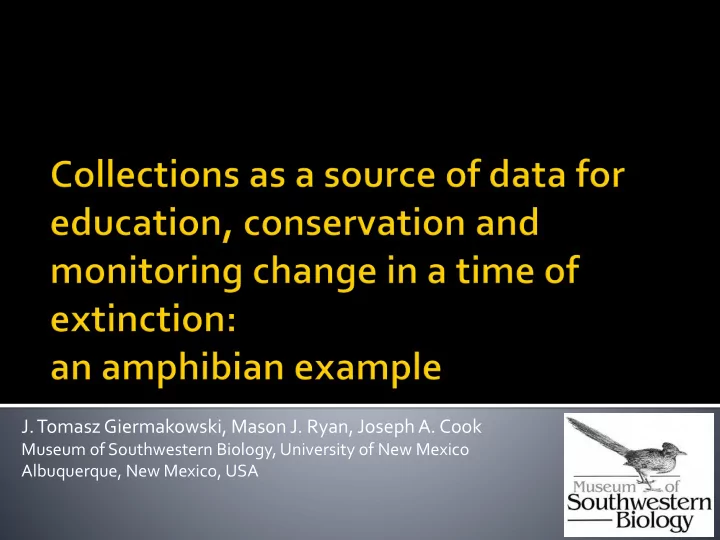

J. Tomasz Giermakowski, Mason J. Ryan, Joseph A. Cook Museum of Southwestern Biology, University of New Mexico Albuquerque, New Mexico, USA
How to increase our visibility and importance? Shift focus from documenting species to conserving species: ▪ Enhance and provide data to wide audiences ▪ Integrate data into education & conservation ▪ AIM-UP! project ▪ Conservation case studies: amphibians
Enhance specimen data ▪ Georeferencing ▪ Collection digitization ▪ Specimen imaging ▪ Scanning of original documentation ▪ Transcription of field notes provides context and allows for new approaches in applied research and conservation
Provide data Examples of efforts: ▪ Vertnet ▪ Arctos (Cicero’s presentation) Integrate collections into education AIM-UP! ▪ Create & disseminate specimen-based educational modules
Emphasize collections as an educational resource Teachers & students can study biodiversity by examining specimens and their associated data Promote multiple core competencies in biology AIM-UP! (poster presentation)
Advancing Integration of Museums into Undergraduate Programs Research Coordinating Network funded by the US National Science Foundation Specific goals: 1. train students in specimen-based research 2. develop instructional tools based on online databases 3. inform educators at non-museum institutions of the learning potential of museum collections 4. interact with the public to increase awareness of the educational importance of natural history museums
Themes over five years: 1. Integrative inventories: complex biotic associations across space & time 2. Geographic variation 3. Evolutionary dynamics of genomes 4. Biotic response to climate change 5. Co-evolving communities of pathogens and hosts as related to emerging disease
Educational modules (available @ aim-up.org) Explore many topics in ecology & evolution ▪ e.g. geographic variation, genome evolution, response to environmental change, range shifts, etc Focus on upper-level undergraduates
How to increase our visibility and importance? Shift focus from documenting species to conserving species: ▪ Enhance and provide data to wide audiences ▪ Integrate data into education & conservation ▪ AIM-UP! project ▪ Conservation case studies: amphibians
Current status of amphibians Single greatest taxa-focused conservation crisis of 21 st century >32% of 6,300 species in immediate threat of extinction >43% species in decline Occurring rapidly with hundreds of die-offs in last 30 yrs Shifting role of collections Historical, specimen-based records Access to field notes Opportunity to make well-informed surveys & management decisions
Direct role of collections Examination of specimens and data ▪ Species distributions – collecting localities Field notes ▪ Qualitative treatment of abundance ▪ If rare – set as low priority ▪ If common – set as a high priority Two case studies: Rediscovery of Craugastor fleischmanni in Costa Rica Status of Anaxyrus microscaphus in New Mexico, USA
Rediscovery of Craugastor fleischmanni in Costa Rica Considered extinct and not detected for 26 years Threatened by disease & habitat loss Examination of historical field notes determined that species was common and easily detected at collection localities Determined high priority to be rediscovered ▪ Survey efforts began in 2005
Rediscovery of Craugastor fleischmanni in Costa Rica Rediscovered in 2010! Instant conservation improvement & proof that it is not extinct
Status of Anaxyrus microscaphus in New Mexico, USA ▪ Declining in Arizona, Nevada, & Utah ▪ Threatened by hybridization, drought, and habitat loss ▪ Restricted to mountainous areas of southwestern New Mexico ▪ Population status unknown Systematic surveys began in 2013 and continuing (2014)
Established 91 survey localities based on historical collection data Identified March-April breeding season most specimens collected outside of breeding season Compared with distribution of Anaxyrus woodhousii congener known to hybridize in AZ
All records of A. woodhousii in Catron Co. are those of A. microscaphus ! 15 localities Combination of tadpoles, juveniles and adults Different collections, collecting dates, collectors, etc…
Re-evaluate distribution of both species in New Mexico Importance of data quality AND Responsibility of researchers/end users
Need to expand educational and scientific potential of natural history collections Collections have much potential for integration into curricula (university and other) Train students to think beyond traditional role of museums Expand role to conservation Specimens & field notes as a crucial aid in setting conservation priorities Can help in evaluation of conservation status of ALL endangered species
In both education and research need to review specimens and associated data for errors Quality of data increases value & credibility of collections Accuracy of data associated with specimens potentially overlooked by both keepers and users of collections
Funding sources United States National Science Foundation New Mexico Dept. of Game and Fish Lewis & Clark Fund IdeaWild! University of New Mexico Department of Biology Bin Zayed Conservation Fund Tinker Foundation
Recommend
More recommend